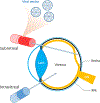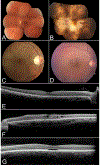Gene and cell-based therapies for inherited retinal disorders: An update
- PMID: 27862925
- PMCID: PMC7536649
- DOI: 10.1002/ajmg.c.31534
Gene and cell-based therapies for inherited retinal disorders: An update
Abstract
Retinal degenerations present a unique challenge as disease progression is irreversible and the retina has little regenerative potential. No current treatments for inherited retinal disease have the ability to reverse blindness, and current dietary supplement recommendations only delay disease progression with varied results. However, the retina is anatomically accessible and capable of being monitored at high resolution in vivo. This, in addition to the immune-privileged status of the eye, has put ocular disease at the forefront of advances in gene- and cell-based therapies. This review provides an update on gene therapies and randomized control trials for inherited retinal disease, including Leber congenital amaurosis, choroideremia, retinitis pigmentosa, Usher syndrome, X-linked retinoschisis, Leber hereditary optic neuropathy, and achromatopsia. New gene-modifying and cell-based strategies are also discussed. © 2016 Wiley Periodicals, Inc.
Keywords: CRISPR; Usher syndrome; achromatopsia; choroideremia; gene therapy; iPSCs; leber congenital amaurosis; leber hereditary optic neuropathy; retinal degeneration; retinitis pigmentosa; retinoschisis; stem cells.
© 2016 Wiley Periodicals, Inc.
Conflict of interest statement
Conflicts of interest: The authors declare no conflicts of interest.
Figures







References
-
- Acland GM, Aguirre GD, Ray J, Zhang Q, Aleman TS, Cideciyan AV, Pearce-Kelling SE, Anand V, Zeng Y, Maguire AM, Jacobson SG, Hauswirth WW, Bennett J. 2001. Gene therapy restores vision in a canine model of childhood blindness. Nat Genet 28:92–95. - PubMed
-
- Algvere PV, Berglin L, Gouras P, Sheng Y. 1994. Transplantation of fetal retinal pigment epithelium in age-related macular degeneration with subfoveal neovascularization. Graefes Arch Clin Exp Ophthalmol 232:707–716. - PubMed
-
- Allocca M, Doria M, Petrillo M, Colella P, GarciaHoyos M, Gibbs D, Kim SR, Maguire A, Rex TS, Di Vicino U, Cutillo L, Sparrow JR, Williams DS, Bennett J, Auricchio A. 2008. Serotype-dependent packaging of large genes in adeno-associated viral vectors results in effective gene delivery in mice. J Clin Invest 118:1955–1964. - PMC - PubMed
-
- Anand V, Barral DC, Zeng Y, Brunsmann F, Maguire AM, Seabra MC, Bennett J. 2003. Gene therapy for choroideremia: In vitro rescue mediated by recombinant adenovirus. Vision Res 43:919–926. - PubMed
Publication types
MeSH terms
Grants and funding
LinkOut - more resources
Full Text Sources
Other Literature Sources
Medical

